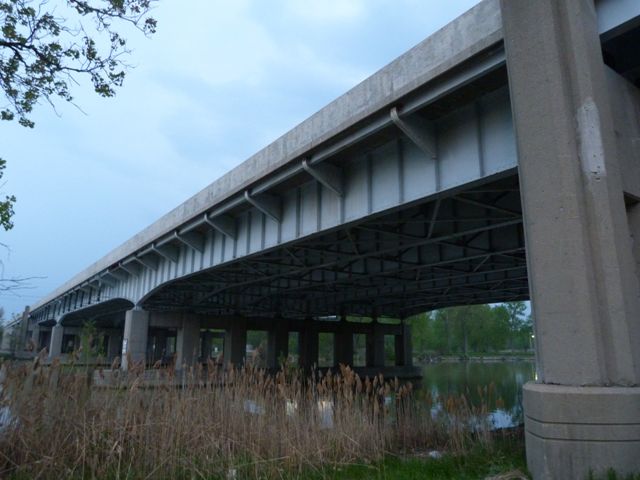We Recommend:
Bach Steel - Experts at historic truss bridge restoration.
BridgeHunter.com Phase 1 is released to the public! - Visit Now
I-75 River Raisin Bridge

Primary Photographer(s): Nathan Holth
Bridge Documented: May 13, 2011
Monroe: Monroe County, Michigan: United States
1955 By Builder/Contractor: Walter Toebe Company and Engineer/Design: Michigan State Highway Department
2005
157.8 Feet (48.1 Meters)
930.2 Feet (283.5 Meters)
109 Feet (33.22 Meters)
3 Main Span(s) and 8 Approach Span(s)
58158151000R030

View Information About HSR Ratings
Bridge Documentation
View Archived National Bridge Inventory Report - Has Additional Details and Evaluation
This bridge is a very large and wide example of a variable depth "haunched" deck plate girder in Michigan. Michigan used bridges of this type in the middle 20th century for larger river crossings on trunkline and Interstate highways. This example, which includes a number of stringer approach spans to carry it over floodplain and two highways, could be describe as two parallel bridges on a common substructure. This is barely detectable since they sit so closely together. This girder and floorbeam system type bridge has four girders to each bridge half.
Information and Findings From Michigan Historic Bridge InventoryThe I-75 Bridge crosses two city streets, and access ramp for I-75 , railroad tracks, and the Raisin River. A marina is located just west of the structure, which is on the eastern edge of Monroe. This bridge was designed with split roadways. A narrow joint separates the two halves of the bridge. The three main spans, which cross the river, are of steel plate deck girder construction, with eight girders per span. There are eight steel stringer approach spans �" two north of the main spans and six to the south, each with twenty steel stringers. Jersey barricades form a median separating the roadways. The median barricades were presumably added when the railings were replaced.Completed in 1955, this structure was the largest constructed for the Detroit-Toledo Expressway. The importance of this bridge is shown in an article which appeared in Michigan Roads and Construction during construction. The article discusses the bridge in detail, including new construction techniques employed by the contractor, Walter Toebe and Company. Toebe, based in Lansing, had been building bridges since at least the early 1920s. They submitted the low bid of $1,477,681 for this structure in July 1954. The same firm was responsible for the I-96 BL (then known as South Cedar Street) Bridge in Lansing, completed in 1952, and the M-63 over CSX Railroad Bridge in St. Joseph. All three of these projects were among the largest completed for the state highway department during the major period of trunkline improvement and expressway development which followed World War II. The Detroit-Toledo Expressway was not the first important north-south road to traverse the eastern section of Monroe County. The Dixie Highway became the first highway in Michigan in 1829. This dirt road had long been an Indian trail. Located essentially parallel to the current I-75, the Dixie Highway was the main route between Detroit and Toledo until the early 1920s, when Telegraph Road was built a short distance to its west. Both roads are still in use, but have mainly carried local traffic since the opening of I-75 in 1956. It was hoped that the new expressway would relieve some of the heavy truck traffic clogging Telegraph Road. Although I-75 does not follow exactly the route of either of the earlier roads, the importance of traffic flow through the corridor is evident. Survey work for the new expressway was completed by June 1952, and bridge work on the approximately 25-mile route began during the 1953-1954 biennium. The road bed and bridges and grade separations were designed to allow for the future addition of a third traffic lane in each direction. Of the interstate highways being built outside of the Detroit metropolitan area, the routes for I-75 and I-94 (Detroit to Chicago) were the furthest toward completion by the mid-1950s. Along with its importance as an early expressway structure, the I-75 Bridge is also structurally significant. This structures stands out in terms of both width and length, and has a large number of spans. The bridge is also quite which, which was required for clearance of the railroad tracks and city streets near each abutment. Replacement of the railings, and introduction of Jersey barricades to divide the structure, are the only alterations to the original design. |
![]()
Photo Galleries and Videos: I-75 River Raisin Bridge
Bridge Photo-Documentation
Original / Full Size PhotosA collection of overview and detail photos. This gallery offers photos in the highest available resolution and file size in a touch-friendly popup viewer.
Alternatively, Browse Without Using Viewer
![]()
Bridge Photo-Documentation
Mobile Optimized PhotosA collection of overview and detail photos. This gallery features data-friendly, fast-loading photos in a touch-friendly popup viewer.
Alternatively, Browse Without Using Viewer
![]()
Maps and Links: I-75 River Raisin Bridge
Coordinates (Latitude, Longitude):
Search For Additional Bridge Listings:
Bridgehunter.com: View listed bridges within 0.5 miles (0.8 kilometers) of this bridge.
Bridgehunter.com: View listed bridges within 10 miles (16 kilometers) of this bridge.
Additional Maps:
Google Streetview (If Available)
GeoHack (Additional Links and Coordinates)
Apple Maps (Via DuckDuckGo Search)
Apple Maps (Apple devices only)
Android: Open Location In Your Map or GPS App
Flickr Gallery (Find Nearby Photos)
Wikimedia Commons (Find Nearby Photos)
Directions Via Sygic For Android
Directions Via Sygic For iOS and Android Dolphin Browser
USGS National Map (United States Only)
Historical USGS Topo Maps (United States Only)
Historic Aerials (United States Only)
CalTopo Maps (United States Only)

